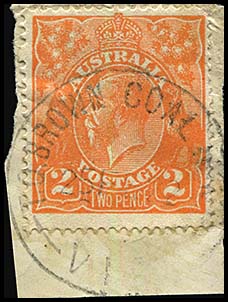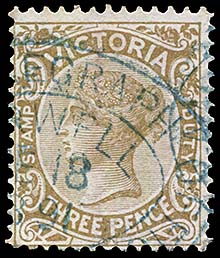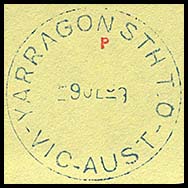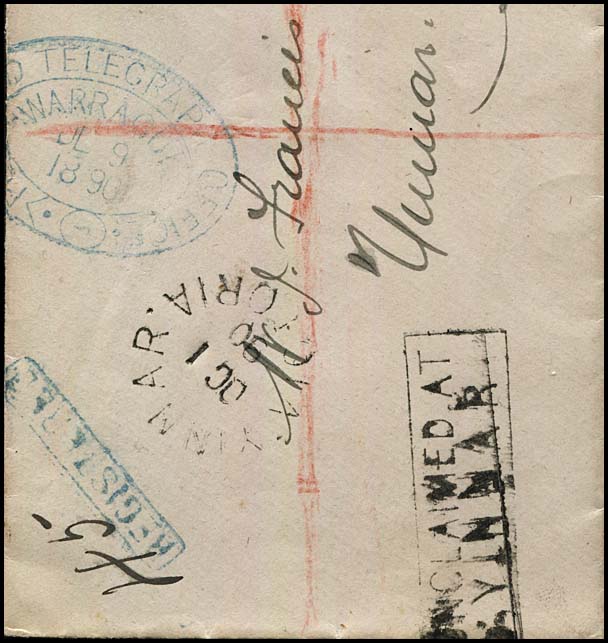Telegraph Offices in Gippsland from Dandenong to Sale.
- Australia 1901-1988
- New South Wales
- Overview of NSW
- Telegraph lines
- Telegraph Offices
- Date stamps
- Forms
- Envelopes
- Instructional annotation
- Collect
- Delayed
- Free
- Immediate Urgent
- Reply paid
- Rates
- Stamps
- 1871 Telegraph stamps
- 1885 proposal
- 1893 proposal
- Queensland
- South Australia
- Tasmania
- Victoria
- Western Australia
- International
- Special aspects
The following Telegraph Offices are included on this page:
Telephone Offices in the region which also used T.O. date stamps but which were not Telegraph Offices include:
| Taberabbera | Yarragon South |
| Berwick.
The Telegraph Office was opened in March 1873. |
|||
The office was issued with a circular rubber TELEGRAPH OFFICE date stamp (RC1-TO):
|
 23 August 1988. (only recorded date). |
| Brown Coal Mine.
The Telegraph Office probably opened on 8 July 1918 at the same time as the Receiving Office was upgraded to a Post Office. The Receiving Office had opened on 3 September 1917. The name Brown Coal Mine was changed to Yallourn North on 1 August 1917. The office was destroyed by fire on 14 May 1934. Brown Coal is about 5 km NE Yallourn. |
||
A T.O. Brown Coal Mine date stamp was issued for use with telegraph business in two formats:
|
 25 February 1922 (earliest recorded date). |
 1 November 1930 (latest recorded date). |
|
 30 May 1936. |
|
| Dandenong. The Telegraph Office was opened in June 1871. The Post Office had opened on 1 July 1848.
The South Bourke and Mornington Journal of 10 December 1879 announced:
|
||
A 1 hole Belt & Buckle date stamp was issued to the Dandenong Post & Telegraph Office.
|
 24 February 1893 (earliest recorded date). |
|
A rubber oval POST OFFICE date stamp was used for telegraphic work.
|
 11 July 1958. Used on AA-DO-13A. |
|
| A Telegraph Office was also opened nearby at the Dandenong Railway Station about 1910 which was reclassified as a Post Office about 1915. | ||
| Drouin (Brandy Creek). West Gippsland. The Gippsland Times of 29 January 1879 reported that the January Meeting of the Buln Buln Shire Council had received correspondence from the Deputy Postmaster General stating that the matter of a Telegraph Office at Drouin was under consideration. On 18 February 1879, the Geelong Advertiser notified that a Telegraph and Money Order Office had been opened at Drouin. Clearly this announcement was related only to a communication connection without a permanent building. In September 1880, the South Bourke and Mornington Journal reported: "Mr. Mason called the attention of the Commissioner of Public Works to the petition presented by a deputation from Drouin respecting the construction of a new Post and Telegraph Office and asked if he had made provision on his estimates for such offices? Mr Langridge replied that no provision had been made on the estimates for the erection of a new Post and Telegraph Office at Drouin". The Post and Telegraph Office opened on 1 September 1881. The establishment was closed on 31 August 1973. Drouin was formerly called Brandy Creek. A Telegraph Office at the Railway Station operated between about 1910 to about 1916. |
|
|
|
Rated: RR. |
 Date cannot be determined. |
|
 13 September 1949. |
|
|
|
|
| Glengarry. East Gippsland. Located about 8 km NNE of Traralgon. It was originally La Trobe Railway Station but renamed Glengarry on 1 December 1884. A Telegraph Office was opened about 1909 and closed about 1911. A Telegraph Office was then opened at the Railway Station on 11 August 1911. It was reclassified as a Post Office about 1915 and closed about 1916. |
||
The office was issued with a T.O. Glengarry date stamp.
|
 29 October 1920 (earliest recorded date). |
|
 18 October 1921. |
 20 September 1926. |
|
| Moe.
The Telegraph Office was opened in January 1877 and another office at the Railway Station opened in July 1878. A Post Office hade been opened on 17 March 1862. The Gippsland Times of 3 April 1878 reported: Through the unfortunate affair which occurred here recently, we have been deprived of the services of an electoral registrar - the want is badly felt and I believe that measures are being taken to have one appointed without delay. I am informed that it is the intention of the postal department to appoint a post-master or post-mistress at Moe, independent of the stationmaster, Mr Hayes who has, since the opening of the line, conducted the joint offices of post, telegraph and stationmaster. The traffic, passenger and goods, of the Moe station has increased so much of late that Mr Hayes has found his hands quite full. Indeed I am greatly surprised that he has so long retained the several posts and so efficiently, considering their extent, discharged the duties. Many efforts have been made to bring about the reinstatement of the young lady who acted as telegraph mistress here before the removal of the office to the railway and I think there is a probability of her appointment at or near the station". Moe was often referred to as Westbury as the two places are only about 3 miles apart (5 kms). |
||
|
||
The office was issued with a one hole Belt and Buckle date stamp:
|
 10 August 1891. Provenance: Freeman, Johnstone. |
|
| Morwell.
in 1875, a Post Office was opened in the town of Morwell altough a Post Office had served the general area from 1870 to 1873. The railway station was erected about 3 miles from the town centre with the station opening about 1877. A Telegraph Office was opened at the Railway Station in August 1879 although the Report for 1879 also indicates that telegraphic communication was extended to Morwell in 1879. It is not known what premises were used as a telegraph Office. Nevertheless, the Morwell Post & Telegraph Office needed replacement by 1882 as reflected in the following printed in the 23 August 1882 Gippsland Times:
Very soon after, the Warragul Guardian of 6 August 1889 reported that: "The Postmaster-General has decided to accept Mr. Jno. Kelleher's offer of a site for a Post and Telegraph office at Morwell. As is usual, when the erection of new public buildings is difficulty. It is to be hoped, however, that the selection will give general satisfaction". The Narracan Shire Advocate of 8 August 1891 reported that "Mr. F. M. Bale was awarded the contract in the sum of £1,499 for the erection of a new post and telegraph office at Morwell". |
||
|
||
The office was issued with a 1 hole Belt and Buckle date stamp:
|
||
|
 18 February 1891. Only example recorded. |
|
|
Situated in the Baw Baw region of Gippsland about 30 km north of Warragul and about 86 kms north east from Melbourne.
|
|
No special date stamp was issued to Nayook for use in the short Telegraph Office period . The ordinary Post Office date stamp was used instead.
|
 14 October 1949. |
|
Noble Park is immediately west of Dandenong. The Telegraph Office |
|
The Office was issued with a rubber circular TELEGRAPH OFFICE date stamp (RC1-TO):
|
 11 October 1988 (possibly last day of operation). |
|
The Telegraph Office was opened in September 1875. |
|
A TELEGRAPH date stamp RC1 - T was issued to the office - probably in the 1980s.
|
 11 April 1983. |
|
The Telegraph Office was opened in August 1877.
|
|
The Office was renamed from Springvale Railway Station Post Office on 20 October 1902. That Office had in turn been established on 1 February 1887. A Telegraph Office was also established at the Railway Station about 1910 but it was closed as a separate office in February 1916. |
|
An oval Telegraph Section (RO-TS2) was issued to the office.
Although the words are indistinct, the inscription SECTION not OFFICE has been used because of the later inscription below and because the word following TELEGRAPH appears to be longer than 6 letters. No reference to this date stamp can be found elsewhere. |
|
A circular date stamp inscribed TELEGRAPH SECTION was issued to the Office during the 1980s.
The Postal Section of the Office had a similar date stamp (43 mm in diameter) with the top inscription being POST OFFICE. |
 |
|
Located south-west of Bairnsdale. A Telegraph Office opened at The Ridge in April 1923 when the Post Office, which had been opened on 7 November 1919, was changed in status. The Office closed on 31 May 1958. |
|
| No special date stamp for use with telegrams was issued to the Office - the usual postal date stamp being used: | |
|
 |
|
The Telegraph line was extended to Toongabbie in May 1878. In 1880, 596 messages were transmitted and in 1882, 966 messages were transmitted. It appears as if the Telegraph Office was transferred to the Railway Station in 1893. In the Report for the Year 1884, it is recorded that the Railway Office at Toongabbie transmitted 626 messages - as well as the closing of the Telegraph Office at Toongabbie. The Railway Station is still listed in the Report for 1887 with 1,543 transmitted and 1,30 received. Looks like the Office lived to fight another day!!! Maybe not for much longer becaise the 1890 Report shows 50 messages transmitted and 32 received with telegraphic revenue totalling £1 11s 1d. |
|
| Trafalgar. West Gippsland. Little is known of this Telegraph Office except it was opened in October 1883 (reported in the Kilmore Free Press (p. 2) of 18 October 1883). A Post Office had been opened on 2 June 1879. It operated until 1 June 1994 when it became a Licensed Post Office. |
|||||||||||||||||||||
|
|||||||||||||||||||||
John Hanley (of Trafalgar) has kindly provided copies of Australia Post records showing the Trafalgar office transmitted telegrams from 1883 to 1891. In the records, there are also two telegrams sent from Trafalgar to Melbourne on 9 June 1910 and on 26 June 1924. |
|
||||||||||||||||||||
As no special date stamp was issued to Trafalgar for use with telegraph work, the usual postal date stamp (SC1-T) was used on telegrams.
|
 28 May 1957. Used on AW-GS-54A. |
||||||||||||||||||||
|
A Telegraph Office was opened at the Railway station about 1910. It was closed about 1916. |
| Traralgon.
A new Telegraph Office was opened at Traralgon in May 1875 - it is not known where. On 27 July 1882, "a deputation of Traralgon residents met the Postmaster-General and requested that a post and telegraph office should be erected at Traralgon. Mr. Bolton replied that as this year's estimates had now been placed before Parliament he could not accede to the request, so far as regards this year, but he would consider it favourably, and, if possible, place a vote for the post and telegraph office on next year's estimates." The Argus. |
|
A subsequent deputation in April 1884 met with Mr. Berry, in his capacity of Postmaster-General
In April 1885:
On 18 November 1885:
The Traralgon Record of 6 November 1891 noted that
For a report on a Telegraphic Money Order fraud see elsewhere. |
A 1 hole Belt & Buckle date stamp was used at Traralgon;
|
 13 September 1889. |
|
|
|
|
| Walhalla.
A Post Office was opened at Stringer's Creek on 22 August 1864. It was renamed Walhalla on 25 March 1868. The Telegraph Office opened in November 1870. Tenders were called at the end of January 1885 for the erection of a new Post and Telegraph Office. The Telegraph Office was a guaranteed office and details of the bond are given in the McGowan Report for 1867 (p. 5). |
 Walhalla township about 1916. |
|
| A 2 hole Belt & Buckle date stamp was issued to the Office. Regarded as being one of the rarest Belt & Buckle datestamps.
|
 11 July 1888. |
 26 June 1889. |
.jpg) 29 May 1893. |
||
| The earliest evidence of the operation of the Warragul Telegraph Office is a telegram transmission form (VC-TO-7B) used at Richmond Telegraph Office for a message sent to Warragul on 6 September 1882. |
|
Date stamps: The Office was only issued with one format of date stamp for use with telegraph work - |
|
 10 April 1890 (on a letter card). Note: day and month are reversed. Only recorded example. |
 16 October 1889. |
 8 April 1893. |
|
|
|
Compete wrapper sent to Gordon & Gotch in Melbourne with the Warragul Belt & Buckle date stamp of 26 July 1889 (detail at left). |
|
Compete wrapper sent to Gordon & Gotch in Melbourne with the Warragul Belt & Buckle date stamp of 13 January 1893 (detail at left). |
|
 9 July 1890. |
|
|
|
A Telegraph Office had been opened at the Warragul Railway Station in March 1878. |
|
A circular TELEGRAPH V.R. date stamp (RC2-T VR) was issued to the Office:
|
 1 February 1955. |
Yarragon South (telephone office). This office was located about 5-6 km south of Yarragon. A Telephone Office was opened on 22 December 1953 and it closed on 18 April 1966. John Hanley of Trafalgar (who has intimate knowledge of the situation)confirmss that the Yarragon South Office only operated as a telephone exchange and was never a Telegraph Office. |
|
A date stamp with the letters T.O. in the upper inscription is known and shown to the right. It is dated six months before the telephone office opened and must therefore be a proof of the date stamp. It is included here as an example that the letters T.O. are ambiguous especially when they have later dates (see also Tabberabbera above).
|
 29 June 1953. |
Comments on Gippsland and the structures which are built must always be placed in the context of the dreadful bush fires which continually ravage the region. Year after year, dreadful stories emerge - even the fires of 7 February 2009 which were the worst in Australia's history:
- 173 people died;
- well over 400 injured;
- 7,562 people displaced; and
- 4,500 square km. burnt out.
It was the eighth deadliest bushfire/wildfire event in recorded history.
The Sydney Morning Herald reported on 5 February 1898 about the fires which were burning then:
"The bush fires now raging in Victoria have reached a record of destruction unprecedented in the history of that colony. The heat on Tuesday attained a point without parallel and from all parts of the forest country, but particularly from Gippsland come thrilling accounts of the ravages of the fires. The settlers outside the towns in these districts have been in most cases hopelessly burnt out, and we got on all sides descriptions of fire-blasted tracts of country and forests ablaze in all directions.
The towns themselves are threatened and in some cases partially destroyed. Drouin, for instance, is beleagured by a circle of flame, South Warragul is surrounded, the labour colony at Leongatha has been devastated, and at Korumburra, Traralgon and other places, hundreds of men assisted by their women-folk have been hard at work fighting back the flames from taking complete possession of these centres of settlement. The vast scale and destructiveness of these fires we have already described but the most thrilling part of the story is that which relates to the perils of men, women and children, and the hardy heroism of the fire-fighters who have thus been suddenly called upon to defend themselves and their possessions against an enemy more destructive and pitiless than war itself.
We have accustomed ourselves to think of the older settled colonies as having progressed beyond the stage of those pioneer perils and difficulties associated with the early struggles of Australian colonisation of which "Black Thursday" is the historic typo. But "Black Thursday" itself has been eclipsed by the havoc now going on and it is well within the truth to say that at no time since Australia has been the home of white men has the story of settlement been illustrated by more stirring incidents of peril, of struggle and of disaster.
The one relieving feature of the situation as it is disclosed by the accounts which have reached us is suggested by the manly qualities of self-sacrificing courage and mutual help which these extraordinary circumstances have called forth".



















